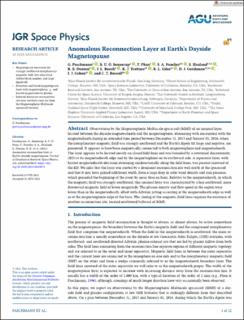| dc.contributor.author | Paschmann, Goetz E. | |
| dc.contributor.author | Sonnerup, Bengt U.Ö. | |
| dc.contributor.author | Phan, Taiduc | |
| dc.contributor.author | Fuselier, Stephen Anthony | |
| dc.contributor.author | Håland, Stein Egil | |
| dc.contributor.author | Denton, Richard E. | |
| dc.contributor.author | Burch, James L. | |
| dc.contributor.author | Trattner, Karlheinz J. | |
| dc.contributor.author | Giles, Barbara L. | |
| dc.contributor.author | Gershman, Daniel J. | |
| dc.contributor.author | Cohen, Ian J. | |
| dc.contributor.author | Russell, Christopher T. | |
| dc.date.accessioned | 2022-01-27T14:43:17Z | |
| dc.date.available | 2022-01-27T14:43:17Z | |
| dc.date.created | 2021-09-23T15:36:16Z | |
| dc.date.issued | 2021 | |
| dc.identifier.issn | 2169-9380 | |
| dc.identifier.uri | https://hdl.handle.net/11250/2893770 | |
| dc.description.abstract | Observations by the Magnetospheric Multiscale spacecraft (MMS) of an unusual layer, located between the dayside magnetosheath and the magnetosphere, alternating with encounters with the magnetosheath during an extended time period between December 31, 2015 and January 01, 2016, when the interplanetary magnetic field was strongly southward and the Earth's dipole tilt large and negative, are presented. It appears to have been magnetically connected to both magnetosphere and magnetosheath. The layer appears to be located mostly on closed field lines and was bounded by a rotational discontinuity (RD) at its magnetosheath edge and by the magnetosphere on its earthward side. A separatrix layer, with heated magnetosheath electrons streaming unidirectionally along the field lines, was present sunward of the RD. We infer that the layer was started by a dominant reconnection site well north of the spacecraft and that it may have gained additional width, from a large drop in solar wind density and ram pressure, which preceded the beginning of the event by more than an hour. Relative to the magnetosheath, in which the magnetic field was strongly southward, this unusual layer was characterized by a less southward, more dawnward magnetic field of lower magnitude. The plasma density and flow speed in the region were lower than in the magnetosheath, albeit with Alfvénic jetting occurring at the magnetosheath edge as well as at the magnetospheric edge of the layer. The closing of the magnetic field lines requires the existence of another reconnection site, located southward/tailward of MMS. | en_US |
| dc.language.iso | eng | en_US |
| dc.publisher | American Geophysical Union | en_US |
| dc.rights | Attribution-NonCommercial-NoDerivatives 4.0 Internasjonal | * |
| dc.rights.uri | http://creativecommons.org/licenses/by-nc-nd/4.0/deed.no | * |
| dc.title | Anomalous Reconnection Layer at Earth’s Dayside Magnetopause | en_US |
| dc.type | Journal article | en_US |
| dc.type | Peer reviewed | en_US |
| dc.description.version | publishedVersion | en_US |
| dc.rights.holder | Copyright 2021 the authors | en_US |
| dc.source.articlenumber | e2021JA029678 | en_US |
| cristin.ispublished | true | |
| cristin.fulltext | original | |
| cristin.qualitycode | 2 | |
| dc.identifier.doi | 10.1029/2021JA029678 | |
| dc.identifier.cristin | 1937802 | |
| dc.source.journal | Journal of Geophysical Research (JGR): Space Physics | en_US |
| dc.relation.project | Norges forskningsråd: 223252 | en_US |
| dc.identifier.citation | Journal of Geophysical Research (JGR): Space Physics. 2021, 126 (9), e2021JA029678. | en_US |
| dc.source.volume | 126 | en_US |
| dc.source.issue | 9 | en_US |

